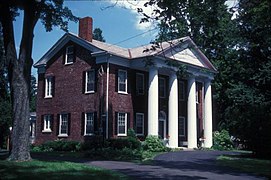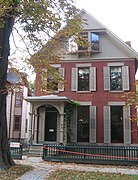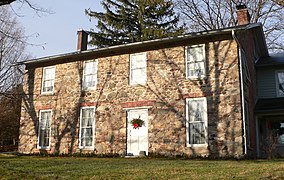Women's Rights National Historical Park

The Women's Rights National Historical Park is a National Historical Park in the US state of New York . It includes four historic sites in the neighboring towns of Seneca Falls and Waterloo, New York , which are of outstanding importance for the history of women's rights in the United States . These include the site of the first U.S. women's rights convention ( Seneca Falls Convention ) in 1848 and three homes for early women's rights activists .
description
Components of the park
The 27,600 m² park was founded on December 8, 1980. It comprises the following four historically significant properties:
- The reconstructed building of the Wesleyan Chapel , built in 1843 , in which on July 19 and 20, 1848 the first American women's rights assembly ( Seneca Falls Convention ) took place, which is regarded as the beginning of the American women's rights movement. Although Elizabeth Cady Stanton was only one of the five organizers of the conference living in Seneca Falls, the place was well known to the others because this Methodist church was free of speech, and it was a haven and meeting place for anti-slavery activities and political rallies . When the property passed into state ownership in 1985, only a few original fragments remained of the original red brick building. These were integrated into the reconstructed replica in such a way that they can be easily recognized as historical elements due to their darker color. Wesleyan Chapel has been on the National Register of Historic Places (NRHP) since August 29, 1980 .
- The Elizabeth Cady Stanton House in Seneca Falls, the former home of suffragette Elizabeth Cady Stanton at 32 Washington Street . She lived with her large family in the house she called "Grassmere" and "Center of the Rebellion" from May 1847 to 1862. The property consists of a large farmhouse, several outbuildings, orchards and ornamental gardens. The residential building has been a National Historic Landmark since June 23, 1965 .
- The M'Clintock House in Waterloo, the former residence of Mary Ann and Thomas M'Clintock. The Quaker couple's house served as the secret shelter of the Underground Railroad network . One of the preparatory meetings for the Seneca Falls Convention took place here. The house has been registered in the NRHP since August 29, 1980.
- The Hunt House in Seneca Falls (136 Fall Street), named after the Quaker couple Richard and Jane Hunt . The wealthy landowner Richard Peel Hunt had the representative house built for his family in 1829. In early July 1848, Jane Hunt invited her fellow campaigners Elizabeth Cady Stanton, Mary Ann M'Clintock and Martha Coffin Wright in honor of the suffragette Lucretia Mott to prepare the Seneca Falls Convention . The Hunt House is a two story red brick residence with four decorative white columns and a portico on the front. The building, which has been registered in the NRHP since 1980, was acquired for the park and restored in 2009.
In the immediate vicinity of Wesleyan Chapel , a large multi-storey visitor center with an education and cultural center was built, in which the Suffrage Press print shop is housed. In the lobby of the visitor center are the bronze statues of the five organizers of the Seneca Falls Convention and some of their male supporters, a work of art by sculptor Lloyd Lillie entitled First Wave .
Votes For Women Historic Trail
The park also manages the Votes For Women Historic Trail, established in 2009 on behalf of the United States Department of the Interior . This road route connects themed upstate New York landmarks that are important to the history of women's suffrage in the United States. Sights along the trail include:
- The Susan B. Anthony House in Rochester , the former home of US women's rights pioneer Susan B. Anthony at 17 Madison Street. The house has been a National Historic Landmark since June 23, 1965.
- The cemetery Mount Hope Cemetery in Rochester with the burial of Susan B. Anthony, Frederick Douglass and other women's rights activists.
- The Antoinette Louisa Brown Blackwell Childhood Home in Henrietta (New York) , where the pastor and suffragette Antoinette Brown Blackwell spent her childhood years. The building was registered in the NRHP in 1989.
- The Women's Rights National Historical Park itself.
See also
Individual evidence
- ↑ Wesleyan Chapel. Women's Rights National Historic Park, accessed September 26, 2018 .
- ↑ Wesleyan Methodist Church in the National Register Information System. National Park Service , accessed October 8, 2018.
- ↑ Elizabeth Cady Stanton House. Women's Rights National Historic Park, accessed September 26, 2018 .
- ↑ List of NHL by State . National Park Service , accessed October 8, 2018.
- ^ M'Clintock House. Women's Rights National Historic Park, accessed September 26, 2018 .
- ^ M'Clintock House on the National Register Information System. National Park Service , accessed October 8, 2018.
- ^ Hunt House on the National Register Information System. National Park Service , accessed October 8, 2018.
- ^ Hunt House. Women's Rights National Historic Park, accessed September 26, 2018 .
- ^ First Wave Statue Exhibit. Women's Rights National Historic Park, accessed September 26, 2018 .
- ↑ List of NHL by State . National Park Service , accessed October 8, 2018.
- ^ Blackwell, Antoinette Louisa Brown, Childhood Home on the National Register Information System. National Park Service , accessed October 8, 2018.
Coordinates: 42 ° 54 ′ 39 " N , 76 ° 48 ′ 0.4" E







